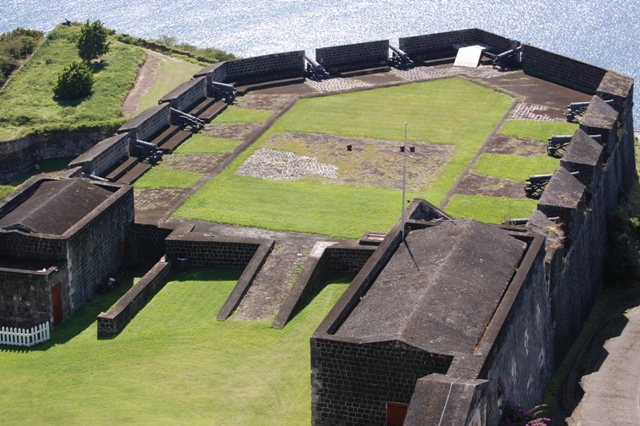
Joe Yogerst, told Larry Bleiberg of USA Today that Brimstone Hill, once called the Gibraltar of the West Indies is “the most impressive of all the British forts I’ve seen in the Caribbean.”
“This former British colonial fort dominates a flat-topped seaside mountain. Abandoned 100 years ago, it has been restored and offers views of a volcano on the nearby Dutch island of Sint Eustatius.”
Yogerst is one of the primary authors of Secret Journeys of a Lifetime: 500 of the World’s-Best Hidden Travel Gems printed in National Geographics.
The other nine sites are in Venezuela, Peru, Alaska and Canada, the United States, South Africa, Japan, England and Cambodia.
Brimstone Hill Fortress National Park is an outstanding, well-preserved example of 17th- and 18th-century military architecture in a Caribbean context. Designed by the British and built by African slave labour, the fortress is testimony to European colonial expansion, the African slave trade and the emergence of new societies in the Caribbean.
The Brimstone Hill Fortress is of historical, cultural and architectural significance, a monument to the ingenuity of the British military engineers who designed it and supervised its construction and to the skill, strength and endurance of the African slaves who built and maintained it. In some of its architectural features, notably the Citadel, are expressed elements of different stages of fortress design; it is an embodiment of European imperialism, and the emergence of a distinctive Caribbean culture. It is indicative of the competition for power and wealth at a crucial stage in world history, and it provides a medium by and through which the geology, ecology and history of the Caribbean can be understood. As managed by a competent local organization on behalf of the people of a young nation, the majority of whose citizens are descended from former slaves, it is a symbol of a colonized African people and of the integrity of Caribbean culture, and as such it can be an inspiration to other young nations in a post-colonial era.
Known as Liamuiga (Fertile Island) to the native Amerindians, Saint Kitts was the first Caribbean island to be permanently settled by both the English (in 1623) and the French (1625), who shared it between 1627 and 1713, when it came under sole English control through the Treaty of Utrecht. Known as the ‘Mother Island’, it provided the model and springboard for English and French colonization in the Caribbean. African slaves were brought in from the earliest years of European settlement, and it was on St. Kitts and the other early colonies that the plantation system, based on sugar production and slavery, had its roots.
Because of its reconstructed and very formidable defences, Saint Kitts became known as the ‘Gibraltar of the Caribbean’.
It successfully drove off an attack by the French Navy in 1806.
From that time onwards the British Navy was able to ensure the security of its island colonies in the Caribbean. The fortress was abandoned as a result of British defence cuts in 1853. The wooden buildings were auctioned and dismantled and masonry buildings were plundered for their cut stone; natural vegetation progressively took over.
Brimstone Hill is a twin-peaked upthrust of volcanic rock 230 m high, clad with limestone over much of its surface. It is covered with scrub, with patches of bare rock in places; the more sheltered areas and ravines are covered with large trees and dense undergrowth. The fortress was constructed to protect part of the coast of the island settled by the English against attack from the sea, and also to provide a place of refuge in case of invasion, until the Royal Navy could secure the surrounding waters and force the surrender of the invading land army. As such it is strategically distinct from the Spanish fortresses.
The principal structures, on different levels on the upper third of the hill, were in dressed stone (basalt) blocks, with a rubble core. The local limestone was used as a decorative element for quoins and for facing round doorways and embrasures. On entering the fortress, the first structure is the Barrier Redoubt, with defensive walls and a small casemate that served as a guardroom and powder magazine. Next comes the North-West Work, which incorporates the stout Magazine Bastion with its associated water catchments and cistern. This in linked by a curtain wall to the South-East Work, the main feature of which is the Orillon Bastion, the counterpart to the Magazine Bastion. A prominent feature here is the bombproof Ordnance Storehouse. The hospital was located within this bastion, but only its foundations survive. Outside the wall is a small cemetery with tombstones. Behind the defensive line is the massive Prince of Wales Bastion.
There is an impressive row of colonnaded basements of the Infantry Officers’ Quarters nearby. This faces the Grand Water Catchment System, consisting of paved catchments, three underground water cisterns, and an open tank. No more than some ruined walls of the Artillery Officers’ Quarters survive, but the kitchen has been restored. In the Commissariat Yard, the Warrant Officers’ Quarters and the Commissariat Storehouse have been reconstructed. The system of walls known as the North-East Work has several barrack blocks behind it, but they are still unrestored. The heart of the fortress is Fort George, the massive masonry structure on one of the twin peaks that dominate the complex, still in an excellent state of repair. It is the earliest surviving British example of the type of fortification known as the ‘polygonal system’, and one of the finest examples known anywhere in the world.
Known as Liamuiga (Fertile Island) to the native Amerindians, St. Kitts was the first Caribbean island to be permanently settled by both the English (in 1623) and the French (1625), who shared it between 1627 and 1713, when it came under sole English control through the Treaty of Utrecht, at the end of the War of the Spanish Succession. Known as the “Mother Island,” it provided the model and the springboard for English and French colonization in the Caribbean.
African slaves were brought in from the earliest years of European settlement, and it was on St Kitts and the other early colonies that the plantation system, based on sugar production and slavery, had its roots. Some syncretic forms that combine elements of the cultures of Europe, Africa, and – to a lesser extent – Native America, can be traced to St Kitts.
The military use of Brimstone Hill began in 1690, when the British mounted cannon on the north-west side todrive the French from Fort Charles, just below the hill. It became a place of refuge in the event of invasion, as, for example, when the French invaded in 1706.
In 1782 the Fortress was besieged by the French, to whom it was surrendered after holding out for a month. However, in the same year the British won a resounding naval victory over the French at the Battle of the Saints, thereby establishing British naval superiority. The Treaty of Versailles in 1783 (which granted independence to the thirteen colonies in North America) restored the island to the British and a period of intensive reconstruction and investment began. Because of its reconstructed and very formidable defences, St. Kitts became known as the “Gibraltar of the Caribbean.” It successfully drove off an attack by the French navy in 1806. From this time onwards the British navy was able to ensure the security of its island colonies in the Caribbean.
The fortress was abandoned as a result of British defence cuts in 1853. The wooden buildings were auctioned and dismantled and masonry buildings were plundered for their cut stone; natural vegetation progressively took over.
(Source http://www.sknvibes.com/news/newsdetails.cfm/51985)



